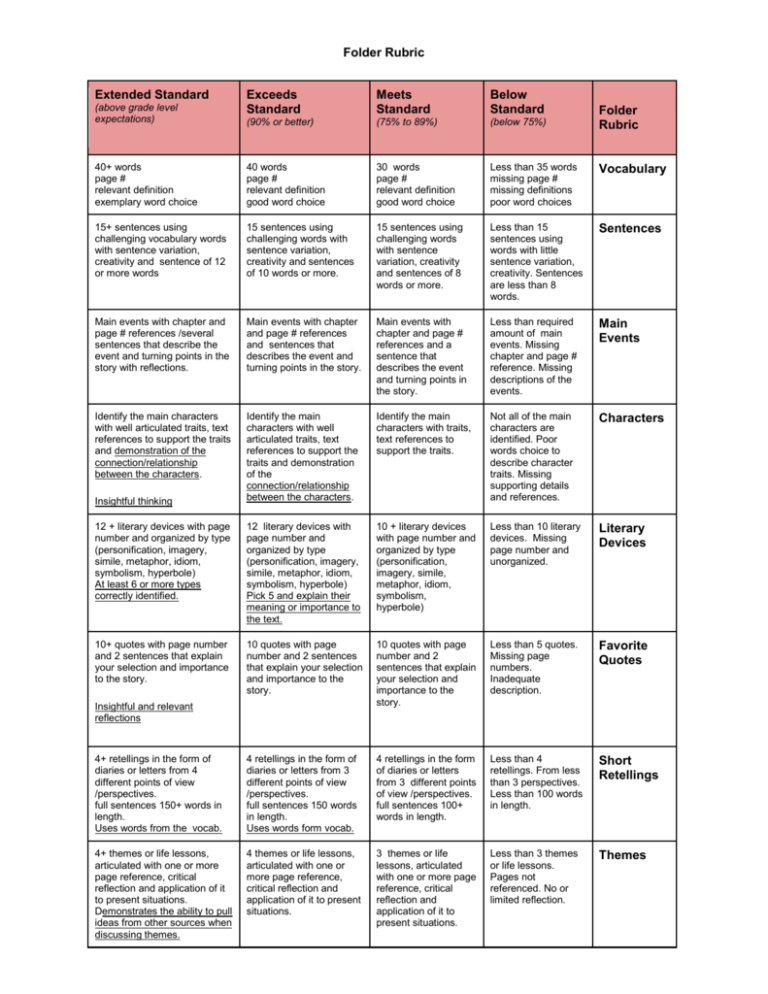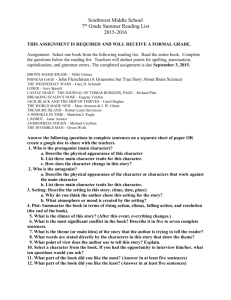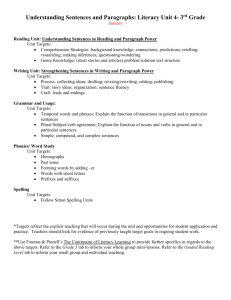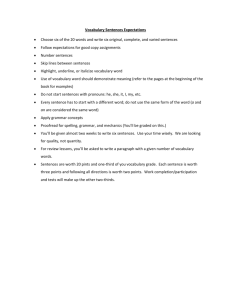Night.Rubrics
advertisement

Folder Rubric Extended Standard Exceeds Standard Meets Standard Below Standard (90% or better) (75% to 89%) (below 75%) 40+ words page # relevant definition exemplary word choice 40 words page # relevant definition good word choice 30 words page # relevant definition good word choice Less than 35 words missing page # missing definitions poor word choices Vocabulary 15+ sentences using challenging vocabulary words with sentence variation, creativity and sentence of 12 or more words 15 sentences using challenging words with sentence variation, creativity and sentences of 10 words or more. 15 sentences using challenging words with sentence variation, creativity and sentences of 8 words or more. Less than 15 sentences using words with little sentence variation, creativity. Sentences are less than 8 words. Sentences Main events with chapter and page # references /several sentences that describe the event and turning points in the story with reflections. Main events with chapter and page # references and sentences that describes the event and turning points in the story. Main events with chapter and page # references and a sentence that describes the event and turning points in the story. Less than required amount of main events. Missing chapter and page # reference. Missing descriptions of the events. Main Events Identify the main characters with well articulated traits, text references to support the traits and demonstration of the connection/relationship between the characters. Identify the main characters with well articulated traits, text references to support the traits and demonstration of the connection/relationship between the characters. Identify the main characters with traits, text references to support the traits. Not all of the main characters are identified. Poor words choice to describe character traits. Missing supporting details and references. Characters 12 + literary devices with page number and organized by type (personification, imagery, simile, metaphor, idiom, symbolism, hyperbole) At least 6 or more types correctly identified. 12 literary devices with page number and organized by type (personification, imagery, simile, metaphor, idiom, symbolism, hyperbole) Pick 5 and explain their meaning or importance to the text. 10 + literary devices with page number and organized by type (personification, imagery, simile, metaphor, idiom, symbolism, hyperbole) Less than 10 literary devices. Missing page number and unorganized. Literary Devices 10+ quotes with page number and 2 sentences that explain your selection and importance to the story. 10 quotes with page number and 2 sentences that explain your selection and importance to the story. 10 quotes with page number and 2 sentences that explain your selection and importance to the story. Less than 5 quotes. Missing page numbers. Inadequate description. Favorite Quotes 4+ retellings in the form of diaries or letters from 4 different points of view /perspectives. full sentences 150+ words in length. Uses words from the vocab. 4 retellings in the form of diaries or letters from 3 different points of view /perspectives. full sentences 150 words in length. Uses words form vocab. 4 retellings in the form of diaries or letters from 3 different points of view /perspectives. full sentences 100+ words in length. Less than 4 retellings. From less than 3 perspectives. Less than 100 words in length. Short Retellings 4+ themes or life lessons, articulated with one or more page reference, critical reflection and application of it to present situations. Demonstrates the ability to pull ideas from other sources when discussing themes. 4 themes or life lessons, articulated with one or more page reference, critical reflection and application of it to present situations. 3 themes or life lessons, articulated with one or more page reference, critical reflection and application of it to present situations. Less than 3 themes or life lessons. Pages not referenced. No or limited reflection. Themes (above grade level expectations) Insightful thinking Insightful and relevant reflections Folder Rubric Class Discussion and Group Rubric Exceeds Standard Meet Standard Below Standard Routinely provides useful ideas. Participates fully in discussions. Puts forth maximum effort to ensure that the task is completed. Usually provides useful ideas to the group. Participates in most discussions. Works to accomplish the task. Rarely provides useful ideas. Participates very little in the discussions. Doesn't work with the group to accomplish the task Contribution Consistently expresses a positive attitude about the task(s) and the group. Never publicly criticizes the project or work of others in the group. Often expresses a positive attitude about the task(s) and the group. Rarely publicly criticizes the project or work of others in the group. Rarely expresses a positive attitude about the task(s) and the group. Occasionally publicly critical of the project or work of others in the group. Working with others Student is on the correct page and is actively reading along (eyes move along the lines) or finger is following words being read aloud by others. Knows and is in the correct place at all times Student is on the correct page and usually appears to be actively reading, but looks at the reader or the pictures occasionally. Can find place easily when called upon to read. Student is on the correct page and seems to read along occasionally. May have a little trouble finding place when called upon to read.Student is on the wrong page OR is clearly reading ahead or behind the person who is reading aloud. Reading along Discussion Responses NA Exceeds Standards Meets Standard Below Standard Participation/ Skills NA Consistently responds on time and goes beyond the requirements. Usually responds on time and follows instructions. Responds late or not at all. Does not follow instructions. Participation NA Content usage is strong as demonstrated by summary in own words and usage of content vocabulary and references from text. Displays adequate level of content but summary in own words is limited.Emerging usage of references to text. Little to no evidence of content. Ideas may be misplaced. Summary is not in own words. Knowledge and Understanding NA Demonstrates the application of content to other situations in a relevant and articulated manner. References to text when applying. Attempts to apply the content to other situation but it may not always be relevant or adequately articulated. Does not apply the content to other situations. Application NA Demonstrates the ability to organize content and ideas by working with parts to whole, categorization and classification. Identifies hidden meaning (symbolism,irony, foreshadowing) Some attempt to organize content, work parts to whole and categorize. Identifies hidden meaning (symbolism,foreshadowin g) with support. Content is repeated back without any dissection,parts to whole or organization. Analyzing NA Well articulated assessment of content and relevant use to problem solve with reference to the text. Statements reflect an attempt to assess content and use it for problem solving. Some reference to text. Content is static with no assessment or attempt to use it in problem solving. Evaluation NA Innovative and original usage of content and ideas to solve problems or create new ideas. Usage is relevant and makes sense. Very limited attempts to create new ideas or solve problems. Ideas may be disconnected or lack relevancy. No evidence or attempt to make innovative changes or application to the content. Synthesis Cumulative Project Exceeds Standard Meets Standard Below Standard Project Rubric Content is embedded throughout the project with direct references, vocabulary and ideas. Relevant, insightful and accurate Content is evident with some direct references, but is not always used in relevant and insightful way. Content is sketchy and is not the primary focus. No references or direct usage. Inaccurate. Content Content and supporting ideas, graphics and project elements support each other and strengthen the product. Content and supporting ideas, graphics and project elements support each other most of the time. Content and supporting ideas, graphics and project elements do not work together and clash at times. Application of Ideas The project reflects significant time and effort with insightful use of content, application of specialized student skills with evidence of new learning. The project reflects some time and effort with adequate use of content and some application of specialized student skills. The project reflects little to no effort and required no specialized student skills. Effort The project reflects exemplary use of the correct materials, skills and effort. It is polished, creative and demonstrates care and intent. Labels and captions are effective The project reflects good use of the materials, skills and effort. It is somewhat polished and demonstrates average care and intent . Labels and captions. Poorly put together, has things missing, little to no skills needed or used. Presentation








